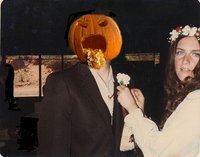Off early to Ingapirca and Hostel Uzhupud. We got a late start (of course. everything is late here) and gassed up and stopped every few minutes to take pictures of the most amazing things -- cacao beans drying on the street (pinkish mooshy things), a wild cat skin, little children, invasion settlements, etc.
It took us several hours to drive to Ingapirca. The Andes Mountains are incredible/amazing. What is even more amazing is how people can live at such high altitudes and do such hard, hard work. The houses (of the Indians) are much nicer than the ones we saw around Daule. Many had electricity. All of the Indians wear hats -- even the 3 or 4 year olds. Different groups of Indians wear different hats. Many speak at least a little Spanish. Around here the native language is one of the many dialects of Quechua, the language that the Incas brought to this area.
We had to stop to check out something on one of the vehicles earlier in the day and we just happened to stop by a group of 6 - 8 Indians standing across the road. One woman was holding a bandaged, bloody hand and another woman was arguing with a man and then a man (the same man?) hit the woman (the one with the cut hand) on the side and back of the head with the back side of his machete!!! One of the other men stopped him. A little girl -- about 8 years old was crying -- it must have been so frightening for her.
We saw many banana groves, eucalyptus trees, giant ferns, corn, etc. on the sides of the hills. The bananas were grown very high up -- well, at a higher altitude than I expected.
The people here have such a hard life, yet I'm not so sure that if I were to have been born here that I would want a life in an industrial place -- especially Guayaquil. i think I would prefer the mountain life -- or at least life in one of the villages in the high mountain valleys. I'm not trying to romanticize it, but if I were to be poor, I think that I'd rather be poor in a mountain village than in a city.
The Indian (I'm not sure if they're Incan or Canari, or what -- have to find that out) women dress in a (usually) black skirt that usually has a colorful trim, what appears to be several layers of blouses, topped off with a colorful sweater, leggings and the ever present hat.
when we got to Ingapirca, we walked by a little house where some people had purchased corn on the cob. The people selling it said that they didn't have any ready for sale but that they would have some cooked by the time we returned from the ruins. They gave us some cheese samples that they had made.
The Ingapirca ruins have two main parts. The first part is Canari -- approximately 3000 years old. The Canaris worshipped the moon god. The Incas came to this area in the 15th century and worshipped the sun god, but tolerated the Canaris god until the Canaris were totally conquered.
We also hiked up to the virgin baths (where we all got revirginated!) and saw the most beautiful 360 degree view of the valley. I hope my pictures come out, but they won't do this place justice -- this will just have to be one of those views that stays in your memory forever.
People have been farming here for centuries, and the human mark is definitely on the land, but it is so much more pleasing to the eye than a factory or an oil slick, or a toxic waste site, or a tire cemetery, etc.
A lovely 14 year old posed for pictures (for sucres). She also asked for a pencil for school, so we gave her three -- one was Emily's Dallas Cowboys pencil. Her little brother asked for money for books for school.
We saw several llamas and 2 or 3 colts or whatever it is you call baby llamas.
An old woman was walking around spinning wool by hand. She wanted money for her picture, too. We saw several women walking around and spinning wool at the same time. Later I was to see other women walking around while weaving hats. No wasted time here.
We also saw men plowing their fields with oxen, as well as sheep with unbobbed tails, lots of dogs, people carrying huge bundles on their backs, little children about 4 or 5 carrying the baby of the family.
Next. . . The Hostel Uzhupud

